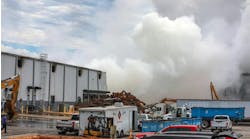10 Rules To Succeed at Process Safety Management
Little over a year ago, on August 12, 2015, a catastrophic explosion occurred in Tianjin, China. More than 165 local residents and firefighters died in that explosion. A Chinese state council investigation described it as “an extraordinarily serious production safety accident” caused by ignition of hazardous materials, improperly or illegally stored at the site. I’m reminded of a similar but not so drastic explosion that happened in 1982 in a Philadelphia chemical plant where I was working. By a stroke of great fortune, no employees or community members were seriously injured. I was away from the plant on business on the day of the explosion. When I returned that evening and went out to the scene I was amazed by how a chemical plant designed and built to rigorous standards could be turned into a pile of smoking spaghetti-like steel in a fraction of a second. The subsequent internal investigation taught us a lot about mistakes that we had made.
Many years later, I was appointed by President George W. Bush to be a board member of the United States Chemical Safety Board (CSB). I worked at the CSB from 2002 until 2012, including serving as its chair from 2008 until 2010. During that period, the CSB performed many investigations, including on some of the more infamous incidents, such as the BP Texas City, Texas, refinery explosion and the Imperial Sugar combustible-dust explosion near Savannah, Georgia. Both of those explosions caused many fatalities and injuries but fortunately led to improved safety in the process industries. (See “Chemical Safety Board Opens Up,” for more on the CSB current chair’s aims and plans.)
During my years at the CSB, I learned that three types of process companies exist. I realize that I’m being simplistic here but hear me out.
The first type of company doesn’t understand the hazards of its operations. It lacks suitable process safety programs and suffers serious accidents with dire consequences. We saw a lot of those companies at the CSB.
The second type of company does understand the hazards and the regulations. It has excellent safety programs and quality people but still experiences incidents, some minor and some very serious. These incidents (fires and explosions) cause lots of frustration and expense for company management!
The third type of company understands the hazards and the regulations. It has excellent safety programs and quality people. It doesn’t have any serious incidents.
Any company in the business of processing hazardous chemicals should strive to become the third type of company.
Top 10 Rules
Based on my many years in the chemical industry and my ten years at the CSB, I have developed my “top ten” rules for process safety success. Let me share them:
1. Leadership (president, chair, board member, plant manager, shift supervisor) must be committed to process safety. If you are the leader of any type of process company, the safety of your employees and the financial success of your firm depend upon your leadership on process safety. Leaders not only must communicate their passion for process safety but also must establish the right organization and apply the needed resources.
2. You must get the best possible people in your company, from senior management to the operators in the control rooms of your facilities. In a perfect world, chemical engineers would oversee the complexities of a plant 24 hours a day. However, many engineers don’t aspire to such an operations role and even those that do wouldn’t enjoy spending their career working rotating shifts. So, you must mandate a stringent hiring process for control room operators — and for all employees for that matter; training and education opportunities must continue throughout a person’s career. Finding and keeping the best people will mean success for your company.
3. You must ensure equipment reliability through an effective program for mechanical integrity (now more commonly called asset integrity). In today’s world, where process plants can operate for 3–4 years or even longer between major turnarounds, the reliability of process equipment is of paramount importance. You must pay attention to everything from piping to valves to control devices to major rotating machinery. To keep the plant running and know that your equipment isn’t going to fail, you will need expertise, such as employees who understand corrosion or the complexities of rotating equipment.
4. Be passionate about taking care of the details. Large process plants are extremely complicated, containing millions of parts and sophisticated electronic equipment and software. Key equipment should have backups so that a single failure can’t cause a shutdown or process incident. A new Boeing 787 airliner contains upwards of about two million parts. Think about the effort needed to ensure that every part is doing its job safely and efficiently. You must apply the same effort in attending to the details in your plant.
5. Establish, if you haven’t already, and carefully track process safety metrics to monitor your operations. These metrics will educate you on how your plant is operating. You should develop both lagging and leading metrics. Some examples of lagging metrics are the number of reportable incidents and the number of times that a pressure relief valve activates. A leading metric should inform you about activities in your plant that can indicate a trend toward a negative outcome — for example, incomplete action items from investigation reports.
6. Take the long view on risk. If an employee alerts you to a problem that only can be resolved by shutting down the process, you must weigh the loss of production from a shutdown and the possibility of a disappointed customer against keeping the process operating until the next scheduled turnaround and risking an incident such as a fire or a chemical spill that may lead to injuries to personnel or damage to the environment. I urge you to take the long-term view and shut down the process today to resolve the problem. By taking the long view, you will incur short-term consequences that soon will be forgotten. On the other hand, an explosion or toxic release, because you delayed taking care of the immediate problem, will cause long-lasting impacts for you and for your company.
7. Prepare for the possibility of an incident, a fire or an explosion with injuries or off-site impact. You should ensure you have a first-class emergency response plan and know your local emergency responders. Run drills with them. In addition, maintain a good relationship with local community leaders. Understand that a serious event will turn your business and personal life upside down. Your day-to-day responsibilities of running a process plant will give way to dealing with federal and state regulatory and investigative agencies, lawyers, insurance adjusters, news media and a host of other people with a need to know what happened. Of course, the best way to avoid this is not to have an incident — but planning ahead to prepare for such an emergency can pay huge dividends if one were to occur. Sit down with your leadership team to develop a contingency plan. Then, work with local responders and the community so they can become familiar and train for their role.
8. Thoroughly investigate all incidents. Always remember that smaller events often very easily could escalate to catastrophic ones and cause a fatality. You should establish a team that not only is well trained on the techniques of incident investigation but also is charged with finding the real root cause of an event. Too often today, what’s described as the root cause actually isn’t. Stating “valve failed” or “operator did not check the oxygen level” doesn’t address the underlying issues: “Why did the valve fail?” or “Why didn’t the operator check the oxygen level?” The most-useful root cause analyses are those that identify a systemic or management issue. (For details on a program one company has successfully used to drive down operator line-up errors, see “Walk the Line.”)
9. Don’t allow complacency to develop. When everything is going well, quality is excellent, and your plant has had no environmental incidents, personnel accidents or process safety issues, people tend to get complacent. Strongly combat this inclination. Keep running a “tight ship.” Any letup in your resolve to have the best safety program can come back to haunt you with a serious near-miss or an actual incident. As a company leader, it’s your responsibility to continually send the message of safe operation and no complacency to all your people. (For details on one effective way to fight complacency, see “Stimulate a Sense of Vulnerability.")
10. Finally, and maybe most important, you must develop and nurture a strong process safety culture within your company. Culture basically means “the way we do things around here.” Of course, a positive safety culture starts with a positive corporate culture (see: “Process Safety Begins in the Board Room"). Employees gauge whether management is just “talking the talk” or really “walking the walk” by its actions: Does management pay attention to safety? Does it ignore the safety suggestions of employees? Does it closely monitor process safety statistics? Does it signal that production is more important than safety? Answer those questions and you’ll know how strong or weak your safety culture is. Ensure that in your organization you are doing things the safest way [1].
JOHN BRESLAND is president of Process Safety Risk Assessment LLC, Shepherdstown, W. Va. E-mail him at [email protected].
REFERENCE
1. Erickson, J., “The Relationship between Corporate Culture and Safety Culture,” p. 73 in “Safety Culture and Effective Safety Management,” National Safety Council, Itasca, Ill. (2000).


